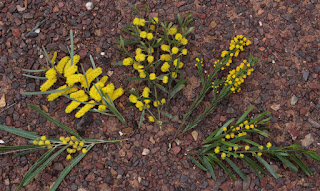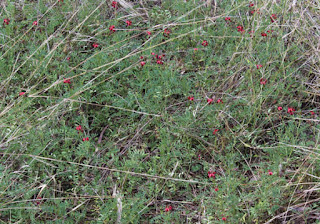A good
turnout for 2015’s first spring outing, with Len Mengel leading members through
a part of the Downs with which he is very familiar. The outing started beside
the well-known dam on the Back Plains – Clifton Road. The dam, which is on
private property, could be seen easily from the road and yielded a number of
bird sightings, listed elsewhere in the newsletter. Plant lovers were also
rewarded with a number of interesting species that are listed at the end of
this report.
Leaving the
dam, we took the Felton View Road, turning first left into Snell Road and then
right onto Mill-brook Road where we were able to stop beside the road for
morning tea and a chance to explore the verges.
Refreshed, we moved on to Leyburn for a comfort stop and then onto the
Condamine Reserve where we stopped for lunch. The spacious reserve has recently
been the focus of some revegetation work under the auspices of the Condamine
Alliance, and offers bush campers well-shaded sites under massive River Red
Gums, (Eucalyptus camaldulensis) along the banks of the Condamine. The
presence of Common Nardoo (Marsilea drummondi) and Mountain Buttercup (Ranunculus
meristus) provided evidence that parts of the Reserve are inundated during
flood.
A leisurely
lunch and investigation of the Reserve was followed by a visit to a popular
swimming area further along the Condamine. Thereafter most members returned
home, while seven hardy souls went on to Durikai State Forest, to see the
famous Durikai mallees, and look for wildflowers. Thank you, Len, for a
relaxing day with lots to see.
Plant list:
By the dam: Scrub Wilga (Geijera salicifolia), Mitchell’s
Native Caper (Capparis mitchelli), Kurrajong (Brachychiton populneus),
Jasmine sp., Notolea sp., Senna
artemisoides subsp. zygophylla, Psydrax odorata subsp. buxifolium,
Cough Bush (Cassinia laevis), Prickly Moses (Acacia farnesiana
(exotic)), Wombat Berry (Eustrephus latifolius).
Millbrook Road: Stiff Jasmine, Sandalwood (Santalum lanceolatum),
Gumbi Gumbi (Pittosporum angustifolium), Orangebark (Denhamia
bilocularis), Square-stemmed Broom (Spartothemnella juncea), White
tamarind (Elattostachys xylocarpa).
Condamine Reserve: Rough-barked Apple (Angophora floribunda),
Common Nardoo (Marsilea drummondi), Mountain Buttercup (Ranunculus meristus), a
spectacular spread of red Slender Darling Pea, (Swainsona brachycarpa) and
the broad leafed Scrub Cherry (Exocarpus latifolius).
(Report by Deb Ford)
On the Durakai
 |
| Acacia sampler, Durikai (photo Trish Gardner) |
| Stone gecko Diplodactylus vittatus at Durikai - photo Diana Ball |
Eucalyptus infera is listed as
vulnerable, and is found only on the southern Darling Downs, usually restricted
to traprock country. We had also hoped to see the wildflowers for which the
area is known but we were too early for them, except for the wattles. There
were plenty of these. We seemed to find a new species every time we stopped.
(Report by Trish Gardner)
Felton/Leyburn Fauna Report
We all gathered at the Ashwell Dam where immediately the birdos trained
their eyes on the dam while the botanists and entomologists studied the road
verges. It wasn’t long before we had an impressive bird list, demonstrating
that these farm dams are so important to wildlife in the dry areas. It isn’t
only water birds that were in abundance but a variety of bush birds were seen
and heard. We had good views of pelicans, spoonbills, and fairy-wrens, and a
Little Grassbird was heard but remained elusive. Our leader, Len, gave us
plenty of time here but eventually we had to move on.
Our morning tea stop was on the verge of
Millbrook Road where we were delighted by the bush birds especially the male
and female Rufous Whistler, Speckled Warblers and Variegated Fairy-wrens. We
took a detour into Leyburn for a comfort stop. This was a good move as far as
the birdos were concerned as a Mugga, Eucalyptus sideroxylon, was in
flower nearby and was full of honeyeaters. We then returned to the Millbrook
area for lunch at the Condamine Reserve. Here the pardalotes fossicked in the
leaves above us and the cockatoos and corellas screeched at us for disturbing their
peace.
Lastly, Len took us to our last stop on the
Condamine at Felton Inn, an old Cobb & Co staging post. Five more bird
species were added to our list including the White-plumed Honeyeater. This is
one of the closest areas to see this species near Toowoomba as it’s at the
eastern limit of its range in Queensland.
P.S. As we were so close to the Durikai
Forest at the end of the outing seven stalwart members continued on to check
out the wattles and mulga in the traprock country. There was blossom but not
many birds with only White-throated Treecreeper, Yellow-faced Honeyeater and
Golden Whistler not seen earlier in the day.
A
= Ashwell Dam (28 species); M = morning tea stop, Millbrook Rd (14 species); L
= Leyburn (8 species); C = lunch stop, Condamine Reserve on Passmore Rd (18 species);
F = Felton Inn on the Condamine River (6 species); R = miscellaneous sightings
along the byways. Total 55 species)
Birds:
Australian
Wood Duck (L, C), Grey Teal (A), Pacific Black Duck (A, C), Hardhead (A),
Australasian Grebe (A), Crested Pigeon (A, M, L), Bar-shouldered Dove (A),
Australasian Darter (A), Little Pied Cormorant (A), Little Black Cormorant (A),
Australian Pelican (A), White-faced Heron (F), Straw-necked Ibis (L), Yellow-billed
Spoonbill (A),Black-shouldered Kite (R), Black Kite (C), Wedge-tailed Eagle
(C), Nankeen Kestrel (R), Masked Lapwing (F), Gull-billed Tern (A), Galah (A,
C), Little Corella (A, L, C), Sulphur-crested Cockatoo (A, C, F), Little
Lorikeet (C), Red-winged Parrot (M), Pale-headed Rosella (C), Laughing
Kookaburra (C), Superb Fairy-wren (A), Red-backed Fairy-wren (A), Variegated
Fairy-wren (M), Speckled Warbler (M), White-throated Gerygone (A, M, C),
Striated Pardalote (A, M, C), White-plumed Honeyeater (F), Noisy Miner (A, M),
Spiny-cheeked Honeyeater (L), Brown Honeyeater (L), Blue-faced Honeyeater (F),
Noisy Friarbird (L), Little Friarbird (C), Striped Honeyeater (A, C), Rufous
Whistler (M), Olive-backed Oriole (M), Grey Butcherbird (A), Pied Butcherbird
(A, C), Australian Magpie (M, C), Pied Currawong (F), Grey Fantail (A, M),
Willie Wagtail (A), Australian Raven (C), Torresian Crow (A, M, C, F),
Apostlebird (M), Little Grassbird (A), Silvereye (A, M), Mistletoebird (L).
Geckoes: Stone
Gecko Diplodactylus vittatus
Butterflies:
Small
Grass-yellow Eurema smilax (C), Cabbage White Pieris rapae (A,M,C), Meadow Argus Junonia villida (C), Wanderer Danaus plexippus (R-Durikai), Long-tailed
Pea Blue Lampides boeticus (C).
Macropods:
Eastern
Grey Kangaroo, Macropus giganteus (R); Red-necked Wallaby, Macropus rufogriseus (M, R); Common Wallaroo, Macropus
robustus (R-Durikai).
Mammals:
Red Fox, Vulpes vulpes (R-dead). Black-tailed
Antechinus (Antechinus arktos)
Those wanting to follow up Bob Fuller’s report of a
discovery of more species of the black tailed Antechinus will find plenty of
interest on the internet. This is a new species discovered last year. At the
time it brought the total number of antechinus species up to 13.
(Report by Lesley Beaton)
The following photos and identification are by Diana Bull:
| Wattle at Durikai |
| Wattle at Durikai |
| In |
| Instar phase of the long-nosed grasshopper Acrida sp. (beside river lunch spot) |
| Senna bush |
| Tragopogan porrifolius |
